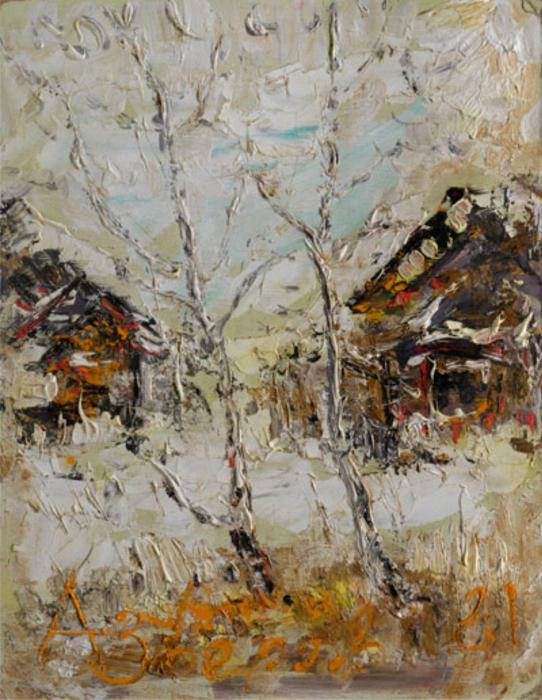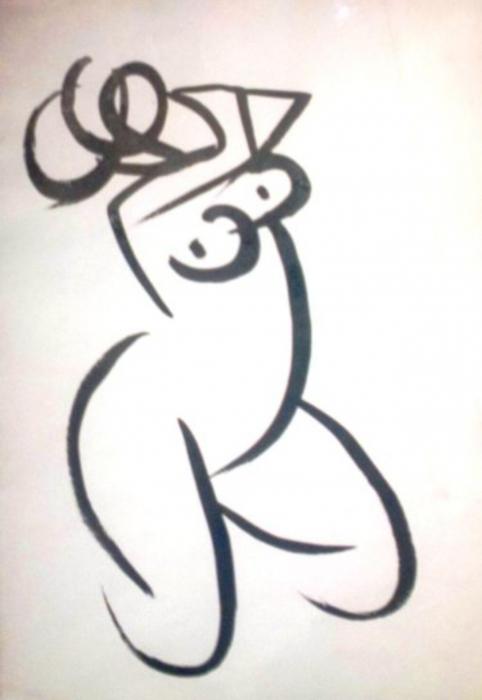Back in the late 60s, in the capital, among the artistic bohemians, they began to talk about a strange homeless man. He went to Moscow eateries, dipped a cigarette butt in ketchup and painted portraits on napkins that he sold for a glass of vodka. And millions are paying for these drawings in the West, because Pablo Picasso himself calls this tramp the best Russian draftsman. Many did not believe in it ...
Anatoly Timofeevich Zverev - an artist whose paintings are now in the best collections of modern art - that was the name of this mythical character.
Ingenious dropout
Other legends composed about him, he told tales about himself ... He was born in Moscow, in Sokolniki, in 1931, in a working-class family. According to his memoirs, he received the first award for his artistic work, the painting "Street Traffic", at 4 years old. He was handed a portrait of Stalin in a beautiful frame.
Drawing at his school was taught by N.V. Sinitsyn, a pupil of the great A.P. Ostroumova-Lebedeva. Art historians are trying to connect the work of Zverev with the Russian avant-garde of the beginning of the century, making him the heir of great traditions. Of course, he is essentially a Russian artist, but it is unrealistic to find any historical roots in the Zverev manner. He himself did not trifle - he called his teacher Leonardo da Vinci, and he argued that he could determine any picture in the Tretyakov Gallery by a small piece.
For some time he studied at the famous Moscow Regional Art College in memory of 1905. Different reasons speak of the reasons for the exclusion: either an untidy appearance, or active discussions with teachers - he doubted their ability to teach anything. And Zverev Anatoly Timofeevich became a painter.
Plots for biography
Alexander Rumnev, actor, dancer, choreographer - that's the name of the person, thanks to whom the artist Anatoly Zverev became known for the first time. The paintings that he saw in the late 40s, struck him with unprecedented freedom. They met when a young painter in Sokolniki Park with a broom-like brush and two buckets with whitewash and cinnabar, with careless movements painted a fence with unprecedented birds.

During the youth festival in 1957 in Moscow, in the Gorky Park, an art studio was organized. For many Moscow young artists, this was the first shocking acquaintance with expressive abstract painting. The Americans condescendingly spoke to the supporters of socialist realism about the freedom to work with paints and pure art. And then a Russian artist appeared scruffy and strange looking. Having splashed out on a cloth of two blue and green paint, he picked up a mop and after ten seconds of furious movements an exquisite woman portrait appeared. Zverev slapped the startled foreigner on the back, stained with paint, and said: “Drop this abstraction, let me teach you how to draw ?!”
“I am a professional, not a craftsman!”
30 thousand works were created by Zverev-artist. Paintings, drawings, collages - his legacy is huge. Many among them are mediocre - the author himself often said that after the 60s he did not draw, but entertained others. But even among the creations of the late period, among the "sweet little faces" there are many amazing masterpieces.
The amazing accuracy of the drawing, the ease and expressiveness of the lines is characteristic of the graphic works of the master. The confidence of the stroke shows the result of daily work - it is not for nothing that contemporaries speak of a permanent notebook and pencil in the hands of Zverev. But the fantastic scale of natural talent is obvious. The genius guided the artist’s hand in the series about the Moscow Zoo, and when he painted nude: “Sitting Nude” (1950s) - a world-class masterpiece. His illustrations to Gogol, Cervantes, Apuleius are amazing.

The complete absence of patterns in the approach to painting did the master a bad job. There are too many fakes among collectors. Famous AZs do not always mean that the painting was painted by the artist Anatoly Zverev. The master’s paintings are too valued at auctions to prevent attempts to imitate his masterly manner. The guarantee of the authenticity of Zverev paintings is the beyond energy of every smear, which is difficult to fake.
Whole life as a performance
It is difficult to find a single art history definition for such a phenomenon as Zverev. An artist whose paintings have an undeniable style unity cannot be attributed to any generally accepted trend. The famous collector George Kostaki called Zverev the first Russian expressionist. They argued with him that the main thing for the artist was the accuracy of life impressions, and passion is only one way to convey them to the viewer.

There are those who call Zverev the master of performance. The process of creating his creations by the master was impressive. A fan of improvisation, he was not averse to entertain others. Even when he had both brushes and paints, he worked with what was at hand. Effective work was carried out with a piece of beetroot, he applied strokes with a razor brush, knife or just fingers. He poured paint on the canvas, smeared it with rags, shoes. I had to protect the place of work so that the spray did not stain others. The birth of a masterpiece was bewitching no less than the picture itself.
Reward or punishment
Unprecedented freedom was imbued with the whole life led by the artist Zverev. His paintings began to be popular and could bring a good income. Anyone else, but not Zverev. Outwardly, he was fully consistent with the myth of the hungry and impoverished fool, noted by God. But this gift became a reward or punishment - is unknown.
And yet, among the husks of the image of a persecuted drunkard, one can discern a person who is fully consistent with the size of the talent. A lot of the poems that have reached us are Zverev, his diaries. This is evidence of high culture, a keen mind, the true artistry of this person.
Schizophrenia aggravated by alcoholism
In the memoirs of those who knew Zverev closely, there is no clearly noble image - a victim of circumstances or a prisoner of the regime. There is a sincere, vulnerable person, ready to help anyone they meet. Remember and absurd, heavy, with traces of prolonged exposure to alcohol and mental damage to the subject. Loneliness and restlessness were both his conscious choice and forced state.
He did not fit well into any creative association, or into the state system as a whole. The jealousy of his talent on the part of his colleagues and the complete rejection of his lifestyle by the authorities led to open conflicts. The creative union did not know such an artist as Anatoly Zverev. An exhibition of his works in 1965 in Paris marked the beginning of his popularity abroad and gave a signal of persecution in his homeland. Until his death (1986), he periodically became a patient in psychiatric clinics, and was not allowed on official opening days due to a lack of education.
Confession
He was called the Russian Van Gogh, in his fate they found similarities with the lives of Modigliani and Pirosmani. But the magnitude and originality of talent made the name of Zverev in the history of culture no less significant.
He carried the cross of his gift in Russia, in Moscow. There will be an interesting museum of the artist and more and more people will be able to discover this amazing new world - the world of Anatoly Zverev.